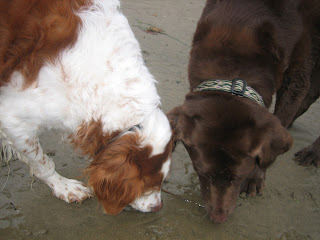A month ago today, we arrived at Joint Base Lewis-McChord. The road trip here was, by far, one of the most amazing experiences of my life. A few stats:
- Drove 3983 miles with 3 dogs in 2 cars and 1 camper
- Crossed 11 state lines (GA, AL, MS, AR, OK, TX, NM, AZ, CA, OR, WA)
- Discovered 8 awesome new mountain bike trails (in GA, AL, MS, OK, TX, NM, AZ)
- Devoured one pound of red Twizzlers, 12 bottles of Diet Coke, and several bags of puppytreats.
 |
| My view for 3,893 miles ... The FunFinder XTRA!! |
 |
| The pups made themselves very comfortable in the camper. |
Doug did a fantastic job of planning our route so that we could MTB in as many new places as possible along the way. We rode awesome trails in the most unexpected places (bring it Mississippi!!), had rides we’d rather forget in others (WTF Oklahoma??), and put others on our Bucket List of Places to Ride Again (Gallup, NM and Palo Duro Canyon, TX). If you’re really interested in the maps, stats and pictures of our rides, check out Doug’s ride blog.
Unfortunately, Mother Nature cut the MTB portion of our road trip short after Sedona, AZ. We had planned to ride in Reno, NV and Bend, OR before heading up to WA, but record early-season snows closed many of the mountain passes, forcing us to re-route through the Mohave Desert and head north through California. Although it was sad that our MTB adventures had come to an end, I found the route through the Mohave to be absolutely spectacular (Doug thinks I’m weird). Our reward for driving through the never-ending desert: In & Out Burger!!!!!
We got re-routed again north of Sacramento by more news of closed mountain passes and Doomsday weather reports, so we decided to head further west and take the coastal route. (The fact that there was an excellent brewery in Eureka didn’t sway that decision at all … honest!!). Although it was raining sideways for the entire trip up the Northern California and Oregon coast, the scenery was absolutely spectacular.
Snow forced us to spend an extra night in Waldport, OR, which is the cutest little seaside town (and just happens to be a few miles from the Rogue Brewing Co headquarters … darn the luck!!!). After a long day of dutifully tasting all that Rogue had to offer, we took the pups for their first swim in the Pacific ocean (not sure they understood it was anything different than the Atlantic, but whatever).
 |
| The sand seemed to smell better on the West Coast. |
 |
| Sandy's sticks were bigger. |
 |
| And Maggie swam like a puppy. |
We finally made the final push on Thanksgiving Eve and made it to Ft. Lewis in just enough time to officially sign-in and stop burning leave. (The Army gave me 8 “free” days to travel from GA to WA. Anything more than that was leave/vacation time.)
The trip across country was amazing on a few different levels. First, the luxury of spending 14 days on an adventure with Doug and the pups – without having to think about work or any other commitments – was simply awesome. That kind of uninterrupted family time is too rare and absolutely precious.
Almost as luxurious was spending hours and hours driving my car, completely alone except for a snoring Maggie in the backseat. I’ll be honest, most of that time was spent singing Nickelback and P!nk at the top of my lungs, or practicing on the steering wheel for my next career as the new drummer of Shinedown, but some of it was spent thinking about bigger world issues and life stuff.
What sticks in my mind though was how amazing it was -- and how lucky I am -- to be able to see so much of the United States. I found myself completely awestruck so many times – and in the most unexpected places – at just how beautiful this country is. Everyone knows how much I love New England, and I always thought I had found heaven when I moved to the White Mountains …. but this trip taught me that there are other parts of the country that are just as beautiful (gasp!!!) as N.H.! This sounds silly, I know, especially from someone who’s traveled as much as I have. But the majority of my travels (outside of New England/New York anyway) have been via plane … it’s a totally different experience to watch the miles pass, one by one, through the swamps and the plains and the desert and the rainforest. If you’ve never driven across the country – or just to a new geographic region – think about treating yourself to that kind of adventure on your next vacation. (Just make sure to update your iPod playlists, and pack plenty of Twizzlers & Diet Coke!).
A lot has happened since we got here too, but I’ll save that for the next post. For now I want to leave you with a song that I listened to at least 300 times during the drive -- “If Today Was Your Last Day” by Nickelback. I’m usually not one for quoting song lyrics (uhhh … hello cheesy) but this one really triggers something for me. Take a listen here, or read the lyrics here, and then tell me that doesn’t make you want to get up and do that one thing that you always wanted to do. Just sayin'...












